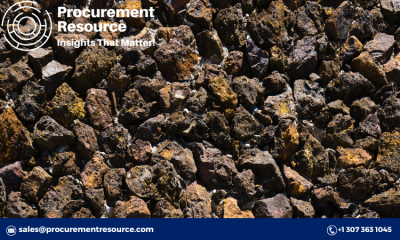Iron ore is a fundamental raw material for steel production and is essential for numerous industries, from construction and automotive to infrastructure development. As the global demand for steel continues to grow, understanding iron ore production costs has become critical for businesses looking to manage their resources effectively. For companies involved in steelmaking or mining, having detailed insights into the cost structure of iron ore production offers a competitive advantage and enables better strategic planning. This article explores the various factors influencing iron ore production costs, common cost drivers, and how cost reports can help industry players optimize their investments and operations.
Request a Free Sample for Iron Ore Production Cost Reports – https://www.procurementresource.com/production-cost-report-store/iron-ore/request-sample
Why Iron Ore is Crucial for Industrial Growth
Iron ore, a rock rich in iron oxides, is extracted and refined to produce iron, which is then processed into steel. Given steel’s crucial role in manufacturing and construction, iron ore is one of the world’s most in-demand raw materials. Steel products are vital for building infrastructure, vehicles, ships, appliances, and much more. Thus, ensuring a steady supply of affordable iron ore is necessary for meeting global industrial and economic demands.
With the right data, companies that rely on iron ore can manage procurement efficiently, optimize their supply chain, and improve budgeting for future investments. Detailed production cost reports can help industries understand each expense involved in iron ore production, giving them a clear picture of their spending and areas for potential cost savings.
Key Factors Impacting Iron Ore Production Costs
Several factors influence the cost of iron ore production, including mining methods, labor, and energy costs. Here’s a closer look at the main factors driving iron ore production costs:
1. Mining Method and Equipment Costs
Iron ore production costs vary significantly based on the type of mining method employed. There are two main types:
-
Open-Pit Mining: Open-pit mining, the most commonly used method for iron ore extraction, involves removing the top layers of soil to access iron ore deposits. It is generally more cost-effective than underground mining, but it requires significant upfront investment in heavy equipment and excavation.
-
Underground Mining: While less common, underground mining is used when iron ore deposits are located deep below the surface. Underground mining incurs higher operational and labor costs than open-pit mining due to the complex infrastructure required for safety and ore extraction.
The choice of mining equipment, including drills, excavators, and transport vehicles, directly impacts production costs. Initial investments in high-capacity and energy-efficient equipment can increase capital expenditure but may reduce operating costs over time.
Read the Full Report – https://www.procurementresource.com/production-cost-report-store/iron-ore
2. Labor and Operational Costs
Labor is a significant cost factor in iron ore production, especially in regions with higher wage rates. Mining operations require skilled labor for various tasks, including drilling, blasting, transportation, and ore processing. Labor costs also vary by region, as countries with higher wage standards have higher operational expenses.
Operational costs also encompass expenses related to equipment maintenance, safety compliance, training, and environmental management. Ensuring a safe working environment is crucial, and mining companies must invest in safety programs and regular equipment inspections, adding to production costs.
3. Energy Costs
Mining iron ore is an energy-intensive process, with high energy costs accounting for a considerable portion of the overall production cost. Power is required at each stage, from blasting and drilling to ore hauling and processing. In areas where electricity costs are high, this can significantly impact production expenses.
Many iron ore producers are seeking ways to reduce energy costs by investing in renewable energy sources or more energy-efficient technologies. For instance, using solar or wind energy can help mitigate the impact of fluctuating energy prices and lower production costs in the long run.
4. Transportation and Logistics Costs
Once extracted, iron ore must be transported to processing plants or export hubs, adding logistics costs to the overall production cost. Rail, truck, or conveyor systems are typically used to transport iron ore, with rail being the most cost-effective over long distances. However, companies operating in remote areas may incur higher logistics costs due to limited infrastructure, leading to increased transportation expenses.
For companies that export iron ore internationally, shipping costs also factor into production expenses. Port fees, customs duties, and shipping rates, which fluctuate based on fuel costs and global trade policies, can add substantial costs to iron ore production.
5. Environmental and Regulatory Compliance
As environmental regulations become stricter, iron ore producers are required to invest in cleaner, more sustainable production methods. Compliance with regulations on air and water pollution, waste disposal, and land reclamation can increase production costs. For instance, mining companies may need to invest in dust suppression systems, water treatment facilities, and waste management programs to minimize their environmental footprint.
Failure to comply with these regulations can lead to fines or other legal consequences, making compliance a necessary cost factor for sustainable operations.
6. Technological Advances and Maintenance
Technological advancements in mining, such as automation, real-time monitoring, and advanced ore processing techniques, can help reduce production costs by improving efficiency. Automation, for instance, reduces the need for manual labor and minimizes operational downtime. The adoption of new technologies, however, requires significant upfront investment in equipment, software, and training.
Maintenance of mining equipment is also essential to avoid costly breakdowns and minimize downtime. Routine maintenance schedules and the replacement of worn-out parts help ensure that production remains consistent and cost-effective.
How Iron Ore Production Cost Reports Benefit Industry Stakeholders
For companies and investors focused on iron ore production, accessing detailed Iron Ore Production Cost Reports provides a competitive edge. Cost reports break down each element of the production process, enabling businesses to understand where their money is spent and where there may be potential savings.
Key Benefits of Iron Ore Production Cost Reports:
-
Detailed Cost Breakdown: Cost reports provide a comprehensive breakdown of each cost element, from labor and energy to transportation and environmental compliance. This detailed view allows companies to pinpoint areas where expenses can be optimized.
-
Real-Time Data and Forecasts: The iron ore market is subject to rapid changes. Real-time data on production costs, along with market forecasts, help companies anticipate price shifts and adapt their procurement and budgeting strategies accordingly.
-
Benchmarking and Industry Comparison: By comparing their production costs with industry benchmarks, companies can evaluate their competitiveness in the market. This allows them to identify areas for improvement and take action to lower costs relative to competitors.
-
Insights into Procurement and Supply Chain Management: Cost reports offer valuable procurement insights, enabling companies to manage their raw materials and energy supplies effectively. For instance, understanding trends in transportation costs helps companies establish long-term contracts with suppliers, reducing exposure to price volatility.
-
Environmental and Compliance Insights: Cost reports include data on environmental regulations and associated costs, helping companies understand their compliance obligations and evaluate the financial impact of regulatory changes.
Why Choose Procurement Resource for Iron Ore Production Cost Reports?
At Procurement Resource, we provide detailed Iron Ore Production Cost Reports tailored to meet the unique needs of industry stakeholders. Our reports offer more than raw data—they provide insights into cost structures, market trends, and strategic opportunities for cost reduction.
Ask an Analyst – https://www.procurementresource.com/production-cost-report-store/iron-ore/ask-an-analyst
What Our Iron Ore Production Cost Reports Offer:
-
Comprehensive Cost Analysis: Our reports cover every factor influencing production costs, from mining and labor to transportation and environmental expenses, giving you a complete understanding of your cost structure.
-
Up-to-Date Market Data: Our team of analysts provides current market data and forecasts, allowing you to stay informed of price trends and market fluctuations, and make well-informed business decisions.
-
Benchmarking and Market Positioning: Our reports allow you to compare your company’s costs with industry benchmarks, helping you identify potential savings and enhance operational efficiency.
-
Procurement and Supply Chain Strategies: We offer actionable insights on managing procurement and supply chain processes more efficiently, reducing the risks associated with fluctuating material and energy costs.
-
Customizable Solutions and Expert Support: Our iron ore production cost reports are customizable to align with your specific business needs. Our analysts provide expert guidance, helping you make informed decisions in a competitive market.
Take Control of Your Iron Ore Production Costs with Procurement Resource
The iron ore market is constantly evolving, with cost pressures and new regulatory challenges requiring businesses to stay proactive. By partnering with Procurement Resource, you gain access to critical insights that empower you to optimize production costs, manage your resources effectively, and enhance your competitive position in the global iron ore market.
Request a Free Sample of Our Iron Ore Production Cost Report
Are you ready to take control of your iron ore production costs? Request a free sample of our Iron Ore Production Cost Report to see how Procurement Resource’s data and insights can benefit your business.
Request Your Free Sample – https://www.procurementresource.com/production-cost-report-store/iron-ore/request-sample
Contact Us
Company Name: Procurement Resource
Contact Person: Amanda Williams
Email: sales@procurementresource.com
Toll-Free Numbers:
USA & Canada: 1 307 363 1045
UK: 44 7537171117
Asia-Pacific (APAC): 91 1203185500
Address: 30 North Gould Street, Sheridan, WY 82801, USA

